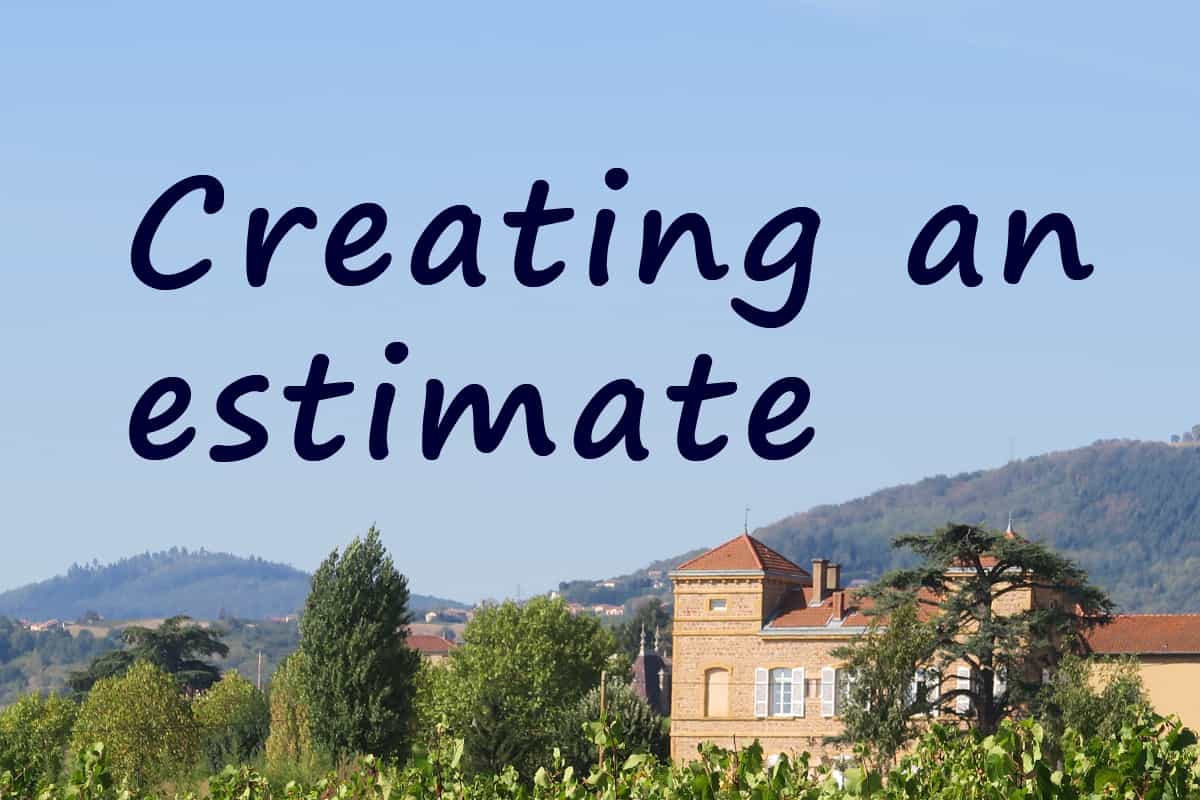For a Project Manager an estimate is much more than the creation of budget numbers. It is a tool that will focus attention on every aspect of the project, and allows the PM to start with whatever information is available and build to a comprehensive plan of action. The estimate helps the PM break the project into categories and consider each section in detail. This process is adaptable to different types of project—let’s look at two different approaches to see how this can work.
What Is Your Project About?
The first step is to define the nature and scope of a project—the “elevator pitch” version. A project can be very specific, such as “build a one-story 1,800 sq. ft. home” or more general, such as “go on a one-month vacation in France.” Even with a single-sentence description of the projects we can see that there will be very different ways to plan and evaluate the outcomes. The house will involve formal compliance with many requirements, and most of the later tasks are dependent on the successful completion of earlier tasks. The vacation plans will slowly develop dependencies as decisions are made, but there may be few consequences if changes are made during the trip.
One thing these estimates have in common is the need for a schedule, so we’ll start with that. Because your estimate will include categories it’s helpful to use a spreadsheet to begin collecting information. You can revise and re-format as the information becomes more detailed. For the house, the schedule might start with these categories: pre-construction, foundation, framing, enclosure (e.g. roof, windows, and doors), sub-trades (e.g. electrical, plumbing, and heating), and finishes. For the trip you might have categories such as dining, lodging, transportation, and museum passes.
The Preliminary Estimate
The preliminary estimate allows the Project Manager to visualize the project, one component at a time. Building a house has some very specific restrictions. The schedule for building the house may incur delays in starting, but the total time can’t be compressed beyond a certain amount and there may additional delays along the way. The PM will allow for schedule contingencies and must verify assumptions with many other players before finalizing the schedule. What is the lead time for obtaining financing? How long will it take to get the relevant permits? How long will it take the plumber to complete the rough-in? Can the electrician start work before the plumber is done? You can’t move in before the inspector issues a Certificate of Occupancy. If the project is delayed you have no choice—you must make adjustments to your plan, and they may be very costly.
The schedule for the vacation in France may be completely dependent on available vacation days from work. The rest of the schedule is optional—it’s up to you to decide what can be done during that time. If the fixed “budget” for the trip is one month then staying an extra week in Avignon might mean you don’t get to see Mont Saint-Michel. However, there may be no consequences to skipping a visit to Versailles if you want to see more of Paris. Your family members may have an opinion about which part to skip, but there are no long-term effects associated with your decision. If your plan is realistic you can resolve some of these options before you go.
The Importance of Realism
Both of these projects illustrate the importance of acknowledging the facts of the situation. There is no benefit to an unrealistic estimate, whether it relates to the schedule or the cost. If you run out of time on your trip you may be disappointed at the end or even stranded in a foreign country; if you run out of money you may not be able to finish building your house.
Let’s take a moment and discuss the meaning of the word “realistic.” It is possible to make mistakes in your estimate due to ignorance (you didn’t know you needed a separate permit for your driveway and there’s a backlog in permit processing). You might forget something (you neglected to include the cost of the toll roads while driving in France). Do the best you can, and add some extra time to the schedule, and add a contingency fund to the budget. Your estimate will be as accurate as possible.
An unrealistic estimate involves wishful thinking. It is based on fantasy—you try to justify the decision to build a house or go on a trip by underestimating the project. This is a recipe for disaster.
I once knew a Project Manager who desperately wanted to win a contract. His company was the low bidder and they were awarded the project…but they had spent every dime of the total contract amount on labor before the project was completed.
The Project Manager was a skilled tradesman, and he estimated the amount of labor required based on his own level of productivity. Unfortunately, none of the people he hired were as efficient as he was, and the project fell farther behind with every week that went by. The schedule and the budget were a train wreck by the time the whole project fell apart near the end.
This project was worth several million dollars, and both the client and the contractor suffered from the disastrous failure. The whole problem could have been avoided if the estimate for the number of hours required had been realistic. Wishing you can complete a project within a certain amount of time is very different from knowing how long it will take. Don’t fall into the wishful-thinking trap!
This brings us to another benefit of estimating all aspects of a project in advance. It’s possible that the estimate will cause you to change your mind about the feasibility of doing the project. If the project is over-budget but still possible, you may make some changes to the scope. This is common when a client requests many bells and whistles, and then puts the project out to bid. When the bids are opened they are all substantially higher than the client was expecting. The process of cutting back on features is sometimes called “value engineering,” and if it’s successful the scope is reduced and the project can proceed. If the renegotiated price is still too high you may decide not to do the project after all.
Once you have established an estimate, it’s time to validate your assumptions. For the house it may mean researching permit costs, getting bids from contractors, and talking to your lender about how much you can borrow. For the trip to France it might mean checking on rates for lodging in Paris, becoming familiar with the exchange rates, deciding whether to rent a car or take the train, and researching the “must-see” attractions.
Update Your Estimate Carefully (and Realistically!)
Keep updating your estimate as you get better information, whether it’s the schedule (how many days will be required for international plane flights?) or costs (lodging near the heart of Paris is expensive). Remember, it’s always better to over-estimate the time and cost; there are always options for an enhancement to the project if you have extra time or money at the end!
If you approach small projects as a Project Manager (PM) you will lay the foundation for becoming an adept PM over time.

